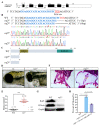PRC1 Stabilizes Cardiac Contraction by Regulating Cardiac Sarcomere Assembly and Cardiac Conduction System Construction
- PMID: 34768802
- PMCID: PMC8583368
- DOI: 10.3390/ijms222111368
PRC1 Stabilizes Cardiac Contraction by Regulating Cardiac Sarcomere Assembly and Cardiac Conduction System Construction
Abstract
Cardiac development is a complex process that is strictly controlled by various factors, including PcG protein complexes. Several studies have reported the critical role of PRC2 in cardiogenesis. However, little is known about the regulation mechanism of PRC1 in embryonic heart development. To gain more insight into the mechanistic role of PRC1 in cardiogenesis, we generated a PRC1 loss-of-function zebrafish line by using the CRISPR/Cas9 system targeting rnf2, a gene encoding the core subunit shared by all PRC1 subfamilies. Our results revealed that Rnf2 is not involved in cardiomyocyte differentiation and heart tube formation, but that it is crucial to maintaining regular cardiac contraction. Further analysis suggested that Rnf2 loss-of-function disrupted cardiac sarcomere assembly through the ectopic activation of non-cardiac sarcomere genes in the developing heart. Meanwhile, Rnf2 deficiency disrupts the construction of the atrioventricular canal and the sinoatrial node by modulating the expression of bmp4 and other atrioventricular canal marker genes, leading to an impaired cardiac conduction system. The disorganized cardiac sarcomere and defective cardiac conduction system together contribute to defective cardiac contraction. Our results emphasize the critical role of PRC1 in the cardiac development.
Keywords: PRC1; Rnf2; cardiac conduction system; cardiac contraction; sarcomere assembly.
Conflict of interest statement
The authors declare no conflict of interest.
Figures






Similar articles
-
Loss of the Polycomb group protein Rnf2 results in derepression of tbx-transcription factors and defects in embryonic and cardiac development.Sci Rep. 2019 Mar 13;9(1):4327. doi: 10.1038/s41598-019-40867-1. Sci Rep. 2019. PMID: 30867528 Free PMC article.
-
The zebrafish genes encoding the Polycomb repressive complex (PRC) 1.Gene. 2011 Apr 1;475(1):10-21. doi: 10.1016/j.gene.2010.12.012. Epub 2010 Dec 30. Gene. 2011. PMID: 21195142
-
Understanding cardiac sarcomere assembly with zebrafish genetics.Anat Rec (Hoboken). 2014 Sep;297(9):1681-93. doi: 10.1002/ar.22975. Anat Rec (Hoboken). 2014. PMID: 25125181 Free PMC article. Review.
-
Knockout of tnni1b in zebrafish causes defects in atrioventricular valve development via the inhibition of the myocardial wnt signaling pathway.FASEB J. 2019 Jan;33(1):696-710. doi: 10.1096/fj.201800481RR. Epub 2018 Jul 25. FASEB J. 2019. PMID: 30044923
-
Build it up-Tear it down: protein quality control in the cardiac sarcomere.Cardiovasc Res. 2009 Feb 15;81(3):439-48. doi: 10.1093/cvr/cvn289. Epub 2008 Oct 29. Cardiovasc Res. 2009. PMID: 18974044 Free PMC article. Review.
Cited by
-
Myocardial Injury Caused by Chronic Alcohol Exposure-A Pilot Study Based on Proteomics.Molecules. 2022 Jul 3;27(13):4284. doi: 10.3390/molecules27134284. Molecules. 2022. PMID: 35807529 Free PMC article.
-
In Search of a Target Gene for a Desirable Phenotype in Aquaculture: Genome Editing of Cyprinidae and Salmonidae Species.Genes (Basel). 2024 Jun 1;15(6):726. doi: 10.3390/genes15060726. Genes (Basel). 2024. PMID: 38927661 Free PMC article. Review.
-
Myocardial Matrix Hydrogels Mitigate Negative Remodeling and Improve Function in Right Heart Failure Model.JACC Basic Transl Sci. 2024 Mar 6;9(3):322-338. doi: 10.1016/j.jacbts.2024.01.006. eCollection 2024 Mar. JACC Basic Transl Sci. 2024. PMID: 38559631 Free PMC article.
-
The Polycomb group gene rnf2 is essential for central and enteric neural system development in zebrafish.Front Neurosci. 2022 Sep 1;16:960149. doi: 10.3389/fnins.2022.960149. eCollection 2022. Front Neurosci. 2022. PMID: 36117635 Free PMC article.
-
Epigenetic Regulation of Mammalian Cardiomyocyte Development.Epigenomes. 2024 Jun 29;8(3):25. doi: 10.3390/epigenomes8030025. Epigenomes. 2024. PMID: 39051183 Free PMC article. Review.
References
MeSH terms
Substances
Grants and funding
LinkOut - more resources
Full Text Sources
Molecular Biology Databases

